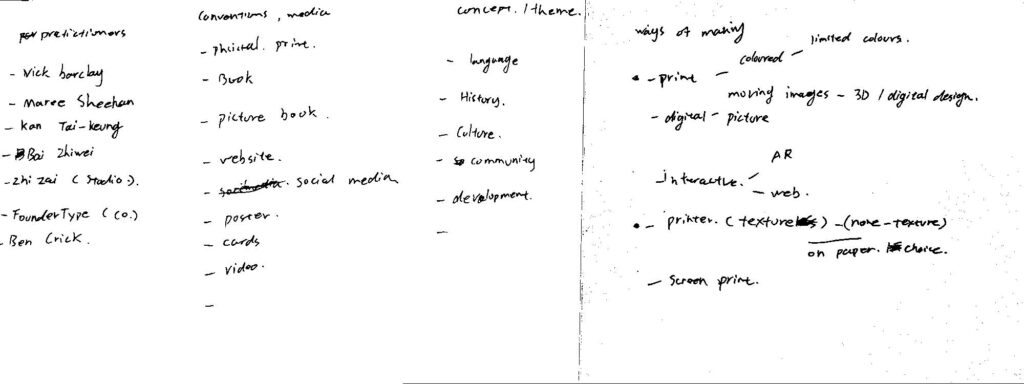GRAD703 – Week 01
Keywords
Language / Culture / Dialect / Connection / Form
Reasoning
Before the start of the semester, I had already considered several possible projects to develop for the final. I’ve always been into culture-related related topics. Therefore, I already have a rough outline of where my project will end.
IDEA 01 – The first topic that popped into my head was analysing the current situation of my native language – Cantonese – and its history and challenges.
I was born in a Cantonese-speaking family, and my life is surrounded by people with the same culture who speak the same language as me. Therefore, I feel like making a work that looks into my culture. This will be about collecting information and making a publication on the Cantonese dialect. Maybe talks about some of the histories, the development. This publication might also include interviews with Cantonese-speaking people, ask them something about the language, and get some insight into how they think of the Cantonese culture. I also wanted to create a survey on the number of Cantonese-speaking people in different age groups. Because I always hear something about younger generations losing the ability to speak the native language, I wanted to know if it is true.
IDEA 02 – The brief history of Chinese characters and their development
language, writing system in particular, are essential to cultural development. The characters in Chinese are thousands of years of continuum stories. As a native speaker and communicating with them on daily basis, I never really consider about the characters themselves. With the recent opportunity, I’ve got to learn about some stories of Chinese characters. And I find they were fascinating. And with this opportunity, I want to explore more characters with their stories and share them with a publication.
IDEA 03 – The construction of the Chinese characters
The Chinese language is quite different from English. Its writing system is different from the vocal system. Most of the characters are a combination of different parts, to signal the meaning, relationship with certain objects, and vocal cue. In this project, I’d like to explore the parts that form the characters.
Keyword explain
Culture – A group of people who shearing the same customs, language, and historical connections.
Language – Communication between groups of people who use the same writing system, and speak in the same tone.
Dialect – Same as language but with less popularity, with fewer users and might not have a complete, documented language system. Usually describe the regional spoken language/communication system used by a small group of people.
Connection – Link between things, used between people, objects, and historical events.
Form – Makeup of certain things.
Map of possible topic

| Practitioners | Media | Theme / Concept | Ways of making |
| Nick Barclay | Physical Print | Language | Coloured/BW Print |
| Maree Sheehan | Booklet | History | 3D – Digital design |
| Kan Tai Keung | Picture Book | Culture | Moving images – digital |
| Bai Xhiwei | Website | Community | AR |
| Zhi Zai (Studio) | Social Media | Development | Web |
| FunderType (Co.) | Poster | Screen print | |
| Ben Crick | Cards | ||
| Video |
What is an exegesis?
Exegesis is a writing document that provides a deeper understanding of the researcher with the design works and its motive, process, and relationship with the creator. The paper studied a large amount of exegesis by students of the Queensland University of Technology in the creative industry (Hamilton & Jaaniste, 2010). They found a pattern emerged, most of them structured with three main parts besides introduction and conclusion, they are positioning of the researcher, case studies, and creative process and reflection. The importance of disguising the creator is that others can understand the person’s background, including identity, cultural relation, and motive. The case studies are essential to know what has been made and how the researcher can offer a different take on the subject. The case study can be their previous works or project that is similar to the idea. The third part can be a demonstration of how the project layout; most of the researchers also include self-reaction in this section to aid future works. Exegesis is not only listing the factual statement and personal take on the matter. But it also provides the researcher with an opportunity to develop the topic with a deeper and wider perspective. Moreover, during the development of the exegesis, the designer can have a clearer understanding of their project and be able to refine the creative thinking behind the decisions.
An exegesis is also a writing of explanation for others to get the insight of one’s mind. The design work can sometimes be extremely visual, the writing can help others to understand the ideology, theme, thinking, and story of the work.
In short, exegesis is a combination of process, thinking, researching, and reflection of oneself in one writing document.
References
Hamilton, J., & Jaaniste, L. (2010). A connective model for the practice-led research exegesis: An analysis of content and structure. Journal of Writing in Creative Practice, 3(1), 31-44.